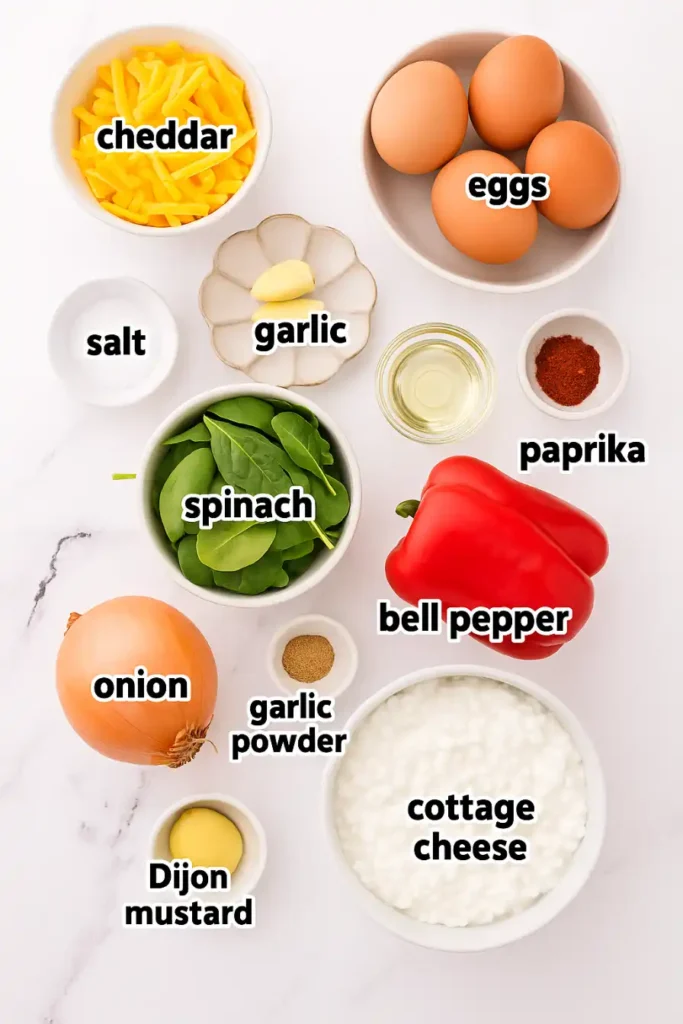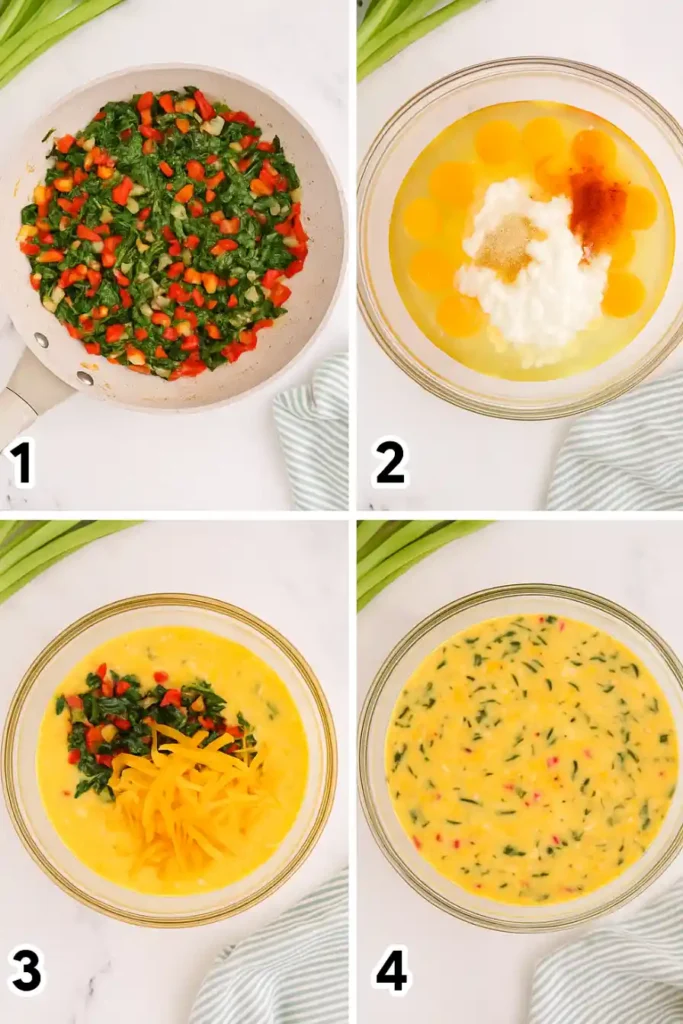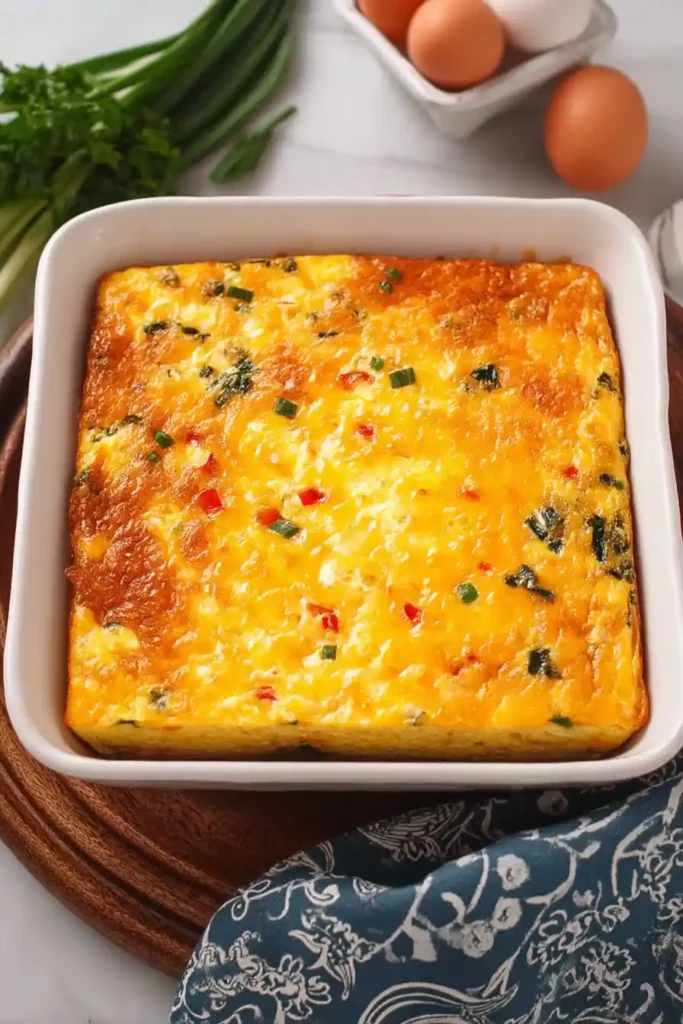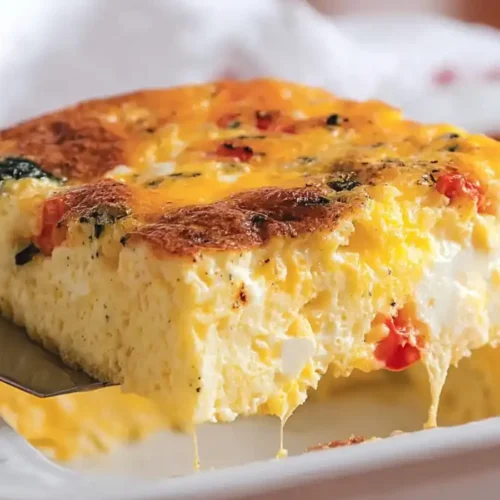If you’re tired of the same old breakfast routine, baked cottage cheese eggs are a game-changer. This dish is packed with protein, loaded with veggies, and incredibly easy to make. It’s warm, hearty, and satisfying—ideal for busy mornings or lazy brunches. Unlike traditional egg casseroles, this version includes cottage cheese, giving it a creamy, slightly tangy flavor and an unbeatable texture. Whether you’re feeding a crowd or meal prepping for the week, this recipe fits the bill.
Why You’ll Love This Recipe
- High-Protein Powerhouse – Eggs and cottage cheese together create a filling, muscle-fueling meal.
- Meal Prep Friendly – Bake once, eat for days. Just slice, reheat, and enjoy.
- Easy to Customize – Add veggies, swap cheeses, or mix in your favorite meats.
- Quick to Make – Simple prep, one bowl, and no fancy tools needed.
- Comfort Food, Reinvented – It’s like a quiche without the crust—fluffy, flavorful, and nourishing.
- Balanced Flavor & Texture – Soft inside, golden on top, and savory in every bite.
This recipe goes beyond ordinary egg bakes. The combination of sautéed vegetables, creamy curds, and gooey cheddar delivers big on both taste and nutrition—without extra effort.
Ingredients Needed

For the Egg Base:
- 12 large eggs
- 2 cups cottage cheese (full-fat or low-fat, your choice)
- 1 tablespoon Dijon mustard
- ½ teaspoon garlic powder
- ½ teaspoon paprika
- ½ teaspoon salt
For the Veggie Mix:
- 1 tablespoon oil (olive, avocado, or grapeseed oil all work well)
- 1 cup diced bell pepper (any color)
- 1 cup finely chopped yellow onion
- 3 cups baby spinach, roughly chopped
- 2 cloves garlic, minced
For the Cheese Layer:
- 2 cups shredded sharp cheddar cheese (divided; swap with Monterey Jack or a mix if preferred)
Optional Garnish:
- Chopped green onions or fresh chives for serving
Ingredient Notes
- Cottage Cheese: Full-fat delivers the creamiest texture, but low-fat versions also work. Avoid fat-free for best flavor and structure.
- Eggs: Use large eggs for consistency. Bringing them to room temperature helps everything combine smoothly.
- Bell Peppers: Choose red, orange, or yellow for sweetness. Green peppers are more bitter and less ideal here.
- Cheddar Cheese: Sharp cheddar gives a bold flavor. Milder cheeses like Monterey Jack create a more delicate dish.
- Spinach: Baby spinach wilts quickly and blends easily. Kale can work but requires more cooking time.
- Dijon Mustard: Adds depth and balances the richness of eggs and cheese.
Substitution Ideas
- Dairy-Free: Use dairy-free cottage cheese and shredded plant-based cheese.
- Vegetarian: This recipe is naturally vegetarian. Want extra protein? Add chopped vegetarian sausage or tofu cubes.
- Low-Fat Option: Use egg whites (6 eggs + 6 egg whites) and low-fat cheeses.
- More Veggies: Try mushrooms, zucchini, or cooked broccoli. Just sauté and drain first to avoid excess moisture.
- Add Meat: Mix in diced cooked bacon, turkey sausage, or leftover chicken for a heartier version.
- Cheese Variations: Pepper Jack adds spice, mozzarella keeps it mellow, or Parmesan boosts the umami.
How to Make Baked Cottage Cheese Eggs

Step-by-Step Instructions
- Preheat & Prep the Dish
Preheat your oven to 350°F (175°C). Lightly grease a 9×13-inch baking dish using oil, butter, or non-stick spray. - Cook the Vegetables
In a medium skillet, heat the oil over medium heat. Add the chopped onion and bell pepper. Sauté for about 4–5 minutes, until the onion becomes translucent and the peppers begin to soften. - Wilt the Spinach & Add Garlic
Stir in the chopped spinach and minced garlic. Cook for another 1–2 minutes, just until the spinach has wilted and the garlic smells fragrant. Remove from heat and set aside to cool slightly. - Mix the Egg Base
In a large mixing bowl, whisk the eggs until yolks and whites are fully blended. Add the cottage cheese, Dijon mustard, garlic powder, paprika, and salt. Whisk again until smooth.
Pro Tip: For a smoother texture, blend the mixture with an immersion blender for a few seconds. Don’t over-blend. - Combine Everything
Add the cooled vegetable mix and 1 cup of the shredded cheese to the egg mixture. Stir gently until evenly combined. - Assemble & Top
Pour the mixture into the prepared casserole dish. Sprinkle the remaining 1 cup of cheddar cheese over the top for a golden, bubbly finish. - Bake in Two Stages
Cover the dish with foil and bake for 25 minutes. Remove the foil and continue baking for another 20–30 minutes, or until the center is fully set and the top is lightly browned.
Visual Cue: The center should jiggle just slightly but not look liquidy. - Cool Before Slicing
Let the bake rest for at least 5–10 minutes before slicing. This helps it set and makes cleaner cuts. - Garnish & Serve
Top with green onions or chives if desired. Serve warm or let cool and portion for later.
Expert Tips for Success
Getting the Perfect Texture
- Don’t overbake—eggs cook fast and become rubbery if left too long.
- Use full-fat cottage cheese for a creamier result.
- Let the bake rest after cooking to firm up.
Ingredient Prep Tips
- Chop veggies finely so they cook evenly and blend into the egg base.
- Press excess moisture from cooked spinach or watery vegetables before mixing in.
Flavor Boosting Secrets
- Add a pinch of red pepper flakes or smoked paprika for depth.
- Saute veggies with a dash of balsamic vinegar for extra sweetness and balance.
Common Mistakes to Avoid
- Skipping the oil—greasing your dish prevents sticking and ensures clean slices.
- Overmixing the eggs—too much whisking can make them dense.
- Not draining watery veggies—this leads to a soggy texture.
Serving and Storage Tips

Serving Suggestions:
- Serve as-is with a side of fruit or avocado.
- Add hot sauce or a dollop of sour cream for a flavor twist.
- Pair with toast, roasted potatoes, or a fresh salad for a balanced meal.
Storage Instructions:
- Refrigerate: Store leftovers in an airtight container in the fridge for up to 4 days.
- Reheat: Microwave slices for 1–2 minutes or reheat in a toaster oven for better texture.
- Freezer-Friendly: Cool completely, slice, and wrap portions individually. Freeze for up to 2 months. Thaw overnight before reheating.
Helpful Notes
- You can bake this in muffin tins for individual portions—just reduce bake time to 20–25 minutes.
- If using watery vegetables like zucchini or mushrooms, cook and drain them well before adding.
- For extra protein, stir in hemp seeds or cooked quinoa.
- Want a crust-like edge? Use a ceramic or glass pan for better browning.
Conclusion
This baked cottage cheese eggs recipe is more than just another breakfast casserole. It’s protein-packed, easy to prep, and endlessly flexible. The cottage cheese creates a rich texture without the heaviness of cream, while the sautéed vegetables and cheddar cheese bring comforting flavors to every bite.
Give this recipe a try and see how easy healthy, homemade breakfasts can be. If you made it, leave a comment and star rating below—it helps others find the recipe too.
What vegetables or add-ins did you use? Let us know in the comments!
And don’t forget to share it on Pinterest or Facebook to spread the breakfast love.
_____________________________

Baked Cottage Cheese Eggs
Equipment
- 9×13-inch baking dish
- Mixing Bowl
- Skillet
Ingredients
Egg Base
- 12 large eggs
- 2 cups cottage cheese full-fat or low-fat
- 1 tbsp Dijon mustard
- 1/2 tsp garlic powder
- 1/2 tsp paprika
- 1/2 tsp salt
Veggie Mix
- 1 tbsp oil olive, avocado, or grapeseed
- 1 cup diced bell pepper any color
- 1 cup finely chopped yellow onion
- 3 cups baby spinach roughly chopped
- 2 cloves garlic minced
Cheese Layer
- 2 cups shredded sharp cheddar cheese divided
Optional Garnish
- chopped green onions or fresh chives for serving
Instructions
- Preheat oven to 350°F (175°C) and grease a 9×13-inch baking dish.
- Heat oil in a skillet. Add onion and bell pepper; sauté for 4–5 minutes until soft.
- Add spinach and garlic; cook for 1–2 minutes until wilted and fragrant. Set aside.
- Whisk eggs, cottage cheese, mustard, garlic powder, paprika, and salt until smooth.
- Add sautéed vegetables and 1 cup of cheese to the egg mixture. Mix gently.
- Pour into baking dish and top with remaining cheese.
- Cover with foil and bake for 25 minutes. Remove foil and bake 20–30 minutes more until set.
- Let rest 5–10 minutes before slicing. Garnish with green onions or chives if desired.
Video
Notes
- Calories: 394 kcal
- Carbohydrates: 9g
- Protein: 29g
- Fat: 27g
- Saturated Fat: 11g
- Polyunsaturated Fat: 3g
- Monounsaturated Fat: 8g
- Cholesterol: 377mg
- Sodium: 825mg
- Potassium: 413mg
- Fiber: 1g
- Sugar: 4g
- Vitamin A: 2491 IU
- Vitamin C: 52mg
- Calcium: 402mg
- Iron: 2mg
Nutrition
Explore More Delicious Recipes
If you enjoyed diving into the Baked Cottage Cheese Eggs, why not explore more delightful dishes from our collection? Here are some must-try recipes to elevate your cooking adventures:
- Pumpkin Pancake Recipe Unbelievably Easy To Make
- Delicious Pancake Bread Recipe For Every Morning
- Cherry Scones Recipe For A Delightful Morning
- Easy Cottage Cheese Flatbread Recipe High Protein
Explore these recipes today to bring more exciting flavors to your table and make every meal memorable!
FAQs
1. What does adding cottage cheese to eggs do?
Cottage cheese makes the eggs extra creamy and rich in protein. It adds a slight tanginess and helps keep the bake moist without needing heavy cream.
2. How do I make baked cottage cheese eggs?
It’s easy—sauté some vegetables, whisk eggs with cottage cheese and seasonings, combine everything in a dish, top with cheese, and bake until set. Full details are in the steps above.
3. Does cottage cheese melt when you bake it?
Not exactly. Cottage cheese softens and blends into the eggs but doesn’t fully melt like cheddar or mozzarella. It helps create a creamy texture.
4. Can you cook cottage cheese in the oven?
Yes, and it holds up well. When baked, it adds moisture and a soft texture to egg dishes, lasagna, and casseroles.
5. What does Gordon Ramsay put in his scrambled eggs?
Gordon Ramsay uses butter, crème fraîche, and sometimes chives. He stirs eggs constantly over low heat and removes them from the heat periodically to control texture.
6. Why do you use cottage cheese in baking?
Cottage cheese adds moisture, protein, and creaminess without making the dish too heavy. It’s a great alternative to cream or ricotta in many baked recipes.












